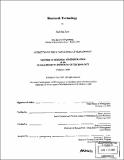| dc.contributor.advisor | John F. Rockart. | en_US |
| dc.contributor.author | San Jose, Ralf, 1970- | en_US |
| dc.contributor.other | Sloan School of Management. | en_US |
| dc.date.accessioned | 2005-08-22T23:31:33Z | |
| dc.date.available | 2005-08-22T23:31:33Z | |
| dc.date.copyright | 2000 | en_US |
| dc.date.issued | 2000 | en_US |
| dc.identifier.uri | http://hdl.handle.net/1721.1/9207 | |
| dc.description | Thesis (M.B.A.)--Massachusetts Institute of Technology, Sloan School of Management, 2000. | en_US |
| dc.description | Also available online at the DSpace at MIT website. | en_US |
| dc.description | Includes bibliographical references. | en_US |
| dc.description.abstract | Bluetooth is the codename adopted by a consortium of wireless equipment manufacturers that is working toward a low-cost, global standard for wireless communication of data and voice. It will operate in the unlicensed ISM band (industrial, scientific, and medical) with gross transfer rate up to lMbps and it will connect devices within a range of 10 or up to lOOm. The benefits of Bluetooth technology are twofold. First, it enables a user to replace the various cables between devices with a universal short-range radio link. For example, a cellular telephone and a portable computer equipped with the Bluetooth technology can interface without the need for cables. Further, they could interoperate with similarly equipped devices such as printers, fax machines, desktop computers and peripherals, and a host of other digital devices. The second major benefit of the Bluetooth technology is its ability to provide a connection between the ad hoc network and existing data networks. Bluetooth technology is designed for wireless personal area networks (WPANs), which are networks of personal electronic devices in close proximity to each other. Expectations for Bluetooth technology are that it will become a major player in the wireless data communications market, due primarily to its simplicity and its support from large companies, many of whom are integrating the technology into their products. Further, Bluetooth members are encouraging vendors to incorporate the technology into their products by waiving intellectual property royalty fees. That being said, this paper will explore the technical aspects of Bluetooth as well as the strategic rationale behind the founding companies. Since e-commerce might be heavily affected by this technology, especially business-to-consumer and consumer-to-consumer, this paper also explores the impact and possible changes in consumer and merchant behaviors. | en_US |
| dc.description.statementofresponsibility | by Ralf San Jose. | en_US |
| dc.format.extent | 78 leaves | en_US |
| dc.format.extent | 4691034 bytes | |
| dc.format.extent | 4690793 bytes | |
| dc.format.mimetype | application/pdf | |
| dc.format.mimetype | application/pdf | |
| dc.language.iso | eng | en_US |
| dc.publisher | Massachusetts Institute of Technology | en_US |
| dc.rights | M.I.T. theses are protected by copyright. They may be viewed from this source for any purpose, but reproduction or distribution in any format is prohibited without written permission. See provided URL for inquiries about permission. | en_US |
| dc.rights.uri | http://dspace.mit.edu/handle/1721.1/7582 | |
| dc.subject | Sloan School of Management. | en_US |
| dc.title | Bluetooth technology | en_US |
| dc.type | Thesis | en_US |
| dc.description.degree | M.B.A. | en_US |
| dc.contributor.department | Sloan School of Management | |
| dc.identifier.oclc | 45483671 | en_US |
